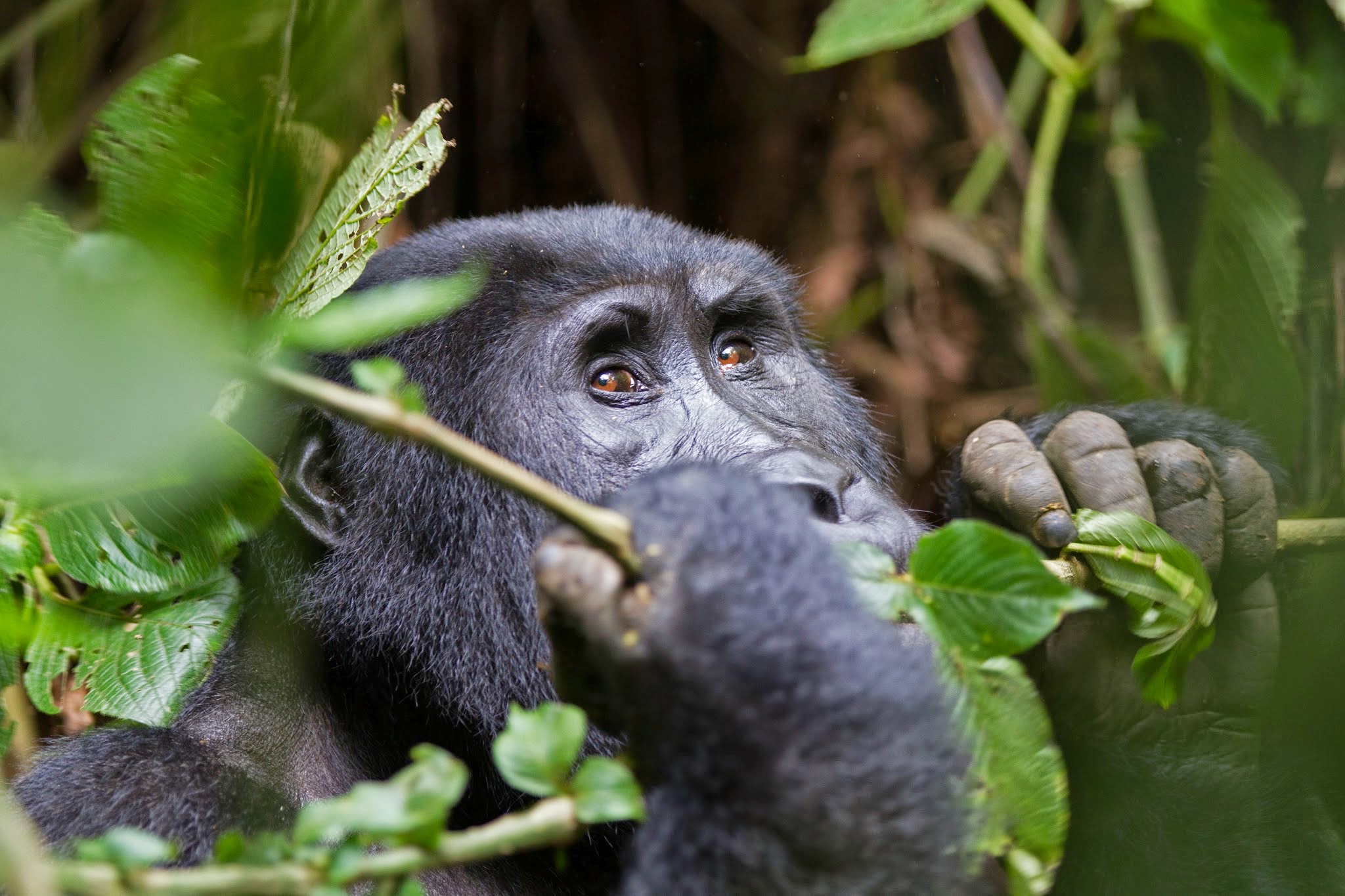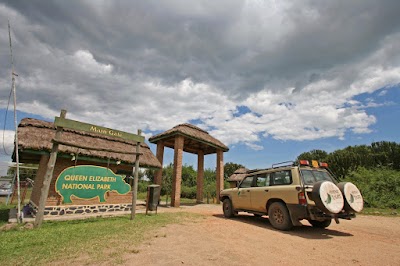Gorilla’s in Uganda

**LOCATION:** Uganda
**PERIOD:** May
**TRAVEL AGENT:** Matoke Tours
At the Antwerp Vacation Fair, we connected with Paul Gevers, one of the founders of Matoke Tours. This Dutch travel agency specializes in Tanzania, Rwanda, and especially Uganda. After about a dozen trips to Africa, where we almost always sought out the predators and their prey, we wanted to experience something entirely different—primates. And, of course, the cherry on top was the mountain gorillas that inhabit the rainforest of Bwindi.
Our journey began with a flight from Brussels, and after a brief stopover in Kigali, we arrived in Entebbe an hour later. Our local Matoke guide, Edwin, awaited us with his jeep and took us to the hotel in the capital, Kampala, for our first overnight stay.
**DAY 2**
The next morning, we embarked on a long but breathtaking drive towards Kibale. We were immediately impressed by the beauty of Uganda. Stunning colors, both in the landscapes and among the people. When you travel through South Africa, you undoubtedly see the country, but this is an entirely different experience.
Kibale National Park is renowned for the large number of chimpanzees that inhabit it. Nearly 1,500 have been counted, and their DNA overlaps with that of humans by 98%. Chimpanzees live in colonies of around a hundred individuals, and over the years, one of these groups has become accustomed to tourists. Thanks to this habituation, there’s a 90% chance of encountering them. We were fortunate with the weather when we set off on our journey. The previous day, it had rained so heavily that many people had to turn back along the way. The apes themselves didn’t pose much of a challenge for us either. After an hour and a half of walking along soggy paths, we reached a small clearing in the otherwise dense forest. There, about four chimpanzees were eating fruits in the trees. The sighting improved when one of the females climbed down from the tree, allowing us to observe her from a short distance. However, we quickly noticed her nervous behavior, indicating that she didn’t appreciate our presence so close. Nonetheless, it resulted in some beautiful photos. The same rules applied to chimpanzees as to gorillas: the visit lasts for one hour, after which you start the return journey through the dense rainforest. In addition to chimps, Kibale is home to 11 other primate species, and for butterfly enthusiasts, it’s a haven. We had never seen so many different beautiful butterflies in one day.
Near Kibale, you’ll find the Bogodi marshland, and it’s well worth taking a walk there in the afternoon. Many monkeys inhabit the area, especially colobus monkeys. After the walk in Bogodi, we returned to Primate Lodge, located on the outskirts of Kibale National Park, as the name suggests, surrounded by various primate species.
**DAY 3**
The next morning, we drove through tea and banana plantations towards Queen Elizabeth National Park. Unfortunately, we only spent one night at the beautiful Ihamba Safari Lodge, highly recommended, with a view of Lake George. After lunch, we headed to the park and enjoyed a fantastic boat ride on the Kazinga Channel. The number of animals on the banks and in the water exceeded our expectations. What stuck with me the most was the high number of pied kingfishers. After the boat ride, we embarked on a jeep safari, but once away from the water, the density of animals was somewhat disappointing. You can see Ugandan Kob in fairly large numbers, but they’re essentially beautiful impalas. Towards the end of the game drive, we came across a group of lions resting in the bushes after a feast. There wasn’t much activity to be seen there.
However, the most exciting story of our trip unfolded that same evening. The gates close at 7 PM, and since we had hoped for some lion activity until the last moment, we had to pick up the pace. Our guide had the adventurous idea of going off-road, which is forbidden in Queen Elizabeth National Park. At one point, Edwin seemed to lose his way and started driving randomly until we ended up in a ditch. It quickly became evident that we wouldn’t get out of there on our own. Moreover, we were only a few hundred meters from those lions, and it was getting darker every minute. At first, it was quite exciting, but after a few hours, the fun wore off. It wasn’t until after 10 PM that the Katunguru Rescue Team found us. The towing service from the nearest village, that is. That night, we went to bed with full stomachs well past midnight after a short night’s rest because we had to continue driving early in the morning towards Bwindi, the realm of the gorillas.
**DAY 4**
Paul Gevers of Matoke Tours told us they had their lodge near Bwindi Impenetrable Forest, where accommodations were much cheaper than at the other lodges at the base of the area where gorilla trekking begins. Lake Mutanda Lodge is also breathtakingly located with views of the Virunga Mountains on the border of Rwanda and the Congo. You have to drive for about an hour to get to the starting point of gorilla tracking, but it’s a small price to pay for the cost difference.
Additionally, in Uganda, gorilla permits in April and May are almost half the price compared to the rest of the year. Paul almost guaranteed that the rains would subside in this area from mid-May, making this period ideal. It turned out to be a good guess because we had ideal weather during our two hikes.
Long before tourists are ready to embark, the trackers are already searching for the different gorilla families. They start where they left the animals the day before and continue from there. This method greatly increases the chances of actually seeing these magnificent primates. First, there’s a brief briefing on how to behave once you reach the gorillas.
The search for the Nkuringo group began easily but ended extremely challenging as the gorillas constantly moved further down a steep path. Moreover, the slope was very slippery due to being at the end of the rainy season. Normally, you must maintain a minimum distance of 7 meters from the gorillas, but if they approach you, there’s little you can do. During our exhausting pursuit, these animals often passed within a meter of us, and it was quite startling to come face to face with an imposing silverback. You’re allowed only one hour with these creatures, and if you’re almost constantly on the move, those 60 minutes pass quickly. I was genuinely pleased that we could go out again the next day because we had relatively few good photo opportunities during this first trek. However, experience teaches that it’s best to stay at the front of the group, allowing you to reach the gorillas first and capture the best photos.
**DAY 5**
The second tracking was indeed a completely different experience as we found ourselves in the real African rainforest much faster with the Rushaga group (Kahungye). Moreover, the first group was relatively close to the local community, making you feel less like you were in the heart of Bwindi. At the beginning of the second trek, the guide informed us that the gorillas we were searching for had fought with wild gorillas earlier in the morning. Usually, this is bad news because they tend to be restless for hours afterward. But our fears were unfounded. This group was very relaxed and paid no attention to our presence whatsoever. An hour later, it was over again, and we began our return journey. We were tired but content, so we had a lukewarm beer with our entire group before heading back for our last night at Lake Mutanda.
The following morning, Edwin took us to the local airport in Kisoro. From there, we flew back to Entebbe, where we boarded an evening flight to Brussels.
This marked the end of an unforgettable visit to the Pearl of Africa.
Stijn Cavens










